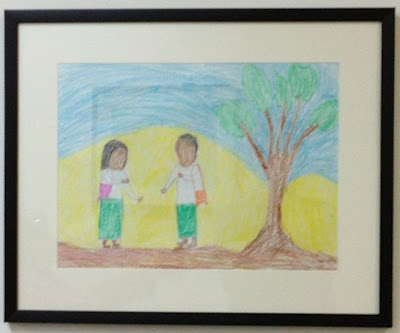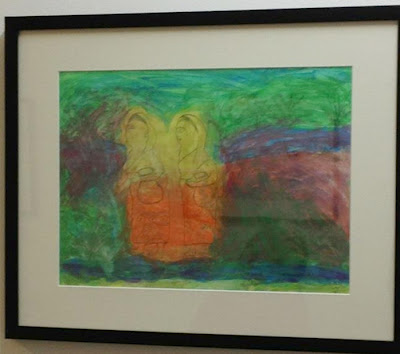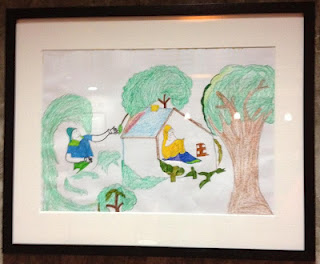Rohingya Community Art fair held in Ireland
Rohingya Men and Women’s Group Art Project


“Powdered Rice”
Art by: Rafika BegumDeén, a traditional seesaw like household equipment used to grunt rice, dried chilli and many more into flour. A smooth headed wood is attached to a long tree trunk at one end and placed on fulcrum. One person uses force of leg to raise and head a wooden or stone hallow chest where rice is place. Another person takes turn to mix ingredient evenly while Deén raises.

The Rohingya community, originally from Burma, were resettled in Carlow in June 2009 as part of the UNHCR (United Nations high commissioner for refugees) resettlement programme. The community lived in refugee camps in Bangladesh from the early 1990’s.
The Rohingyas number approximately 1.5 million and have endured continued persecution and ethnic cleansing in Burma. About 1.5 million Rohingyas have been living in exile in many countries all over the world. The Rohingyas in Burma continue to suffer from several forms of persecution and human rights violations.
25 Rohingya men and women, over a period of 6 weeks, took part in an art project focusing primarily on their culture and their journey to Ireland. The mean’s group, supported by St. Catherine’s community services Center and the woman’s group supported by Carlow County development partnership Ltd. Were offered an outlet through art to explore their previous life with a positive focus on their future life in Ireland. These sessions local artist Elsie Nolan facilitated the men and women to create the beautiful pieces of work you see here on 08 May 2012.

Match funding for the project was provided by UNUM Carlow and Carlow county enterprise board. This project is led by St. Catherine’s community services Center under the Carlow County development board, co-financed by the European commission under the European refugee fund and is supported by the office for the promotion of migrant integration in the department of justice and equality and Pobal.
They have told their story through art at a fascinating new exhibition, which opened in Visual Centre for Contemporary Arts on the 1st of May 2012. The exhibition is running for a two weeks stint until the 14th of May.
Followings are some relevant Arts

“Plowing Machines”
Art by: Sayed Alam
A farmer plowing a paddy field with his cattle attached to a plow. Most of the farmers in
Arakan utilize cattle in the place of plowing machines due to many social-economic reasons.

“A Lady with Water”
Art by: Mohammed Rafique
A Rohingya lady carrying water with jar from a pond. Rohingya community use water from various sources such as mostly urban community use from well and tube pipe and rural community use too but mostly from clean ponds.

“School Girls”
Art by: Gul SaherTwo girls in school uniforms; white shirt and green sarong with traditional hanging school bags and the girls are also seen on barefoot. There are numerous obstacles faced by the school children while going to school due to the lack of development in the facilities for education and transportation.

“Human-powered Harvesting”
Art by: Mohammed Rafique
Rohingyas from urban areas live on business, most of the rural Rohingyas very much depend on seasonal agriculture. Harvesting paddy in Rohingya community
mainly involves almost non-machine power; cattle and men are main source of harvesting the paddy in replace of tractors as seen in this painting.

“Sunset View”
Art by: Rashid Ahmed
A boy climbing up a palm tree to enjoy the beautiful sun setting toward the Naf river. Palm and coconut trees are some of the important trees which nuts, trunks and leaves being used for various purposes all across the seasons.

“Happy Raining Season”
Art by: Osman Johar
For children, raining season is the most enjoyable season. Children run under the rain playing, fishing in shallow water, taking off shirts once school bells rung. Unfortunately, it is also the season where many children get sick, injured, drawn or bitten by insects and
snake.

“Tying Harvesting Cattle”
Art by: Mohammed Eliyas
An elderly Rohingya farmer taking his bull to a paddy field tied on a stick which will be firmly fixed in the ground so that the bull will not able to destroy the growing paddy or caught by other people if the bull enters other paddy fields.

“Collecting Water”
Art by: Rafika Begum
Two ladies who are collecting water from the river. The river and water areas are very important in our lives for many different reasons.
“Two Wonder Kids”
Art by: Osman Johar
Two kid sit wondering the return of their parents from harvesting, from the darkest daily
days their parents faced for living.

“Chicken”
Art by: Noor Khatun
Chicken are used in Rohingya household for various purpose. They are used as food, to lay egg, to fight in sport and not to forget as an alarm clock to wake up all.
“Kuijja”
Art by: Shah Alam
Kuijja, a dry hay fodder in the form of a dome with a strong bamboo in the middle and used for feeding cattle especially in the raining season.

“Escape Exile”
Art by: Hamida Begum
More than 90 of Rohingyas in exile use boats, canoes to cross Naf River from various persecutions. Many have been vanished while escaping although the river is not hostile and wide approximately ranging 1.5 to 3.5 km wide.

“Moóc”
Art by: Hossein Ahmed
The man is on a journey with his ox and cart and has stopped at a moóc (well) for a drink
of water on his journey. He takes the water from the well in a ceramic bowl.

“Air Journey”
Art by: Robi Alam
Air Journey from Bangladesh to Ireland was our first ever experience of flying. Although there are local airline in Arakan, it is unaffordable and hardly able to use for Rohingyas due to restrictions placed on them.

“Afford and Pray”
Art by: Noor Jahan
Afford and pray go hand to hand for an ordinary Rohingya family. Traditionally men are bread feeder earning to support family and women as housewives taking care of children and praying for success. There are many families in rural areas where women.
The Rohingyas number approximately 1.5 million and have endured continued persecution and ethnic cleansing in Burma. About 1.5 million Rohingyas have been living in exile in many countries all over the world. The Rohingyas in Burma continue to suffer from several forms of persecution and human rights violations.
25 Rohingya men and women, over a period of 6 weeks, took part in an art project focusing primarily on their culture and their journey to Ireland. The mean’s group, supported by St. Catherine’s community services Center and the woman’s group supported by Carlow County development partnership Ltd. Were offered an outlet through art to explore their previous life with a positive focus on their future life in Ireland. These sessions local artist Elsie Nolan facilitated the men and women to create the beautiful pieces of work you see here on 08 May 2012.

Match funding for the project was provided by UNUM Carlow and Carlow county enterprise board. This project is led by St. Catherine’s community services Center under the Carlow County development board, co-financed by the European commission under the European refugee fund and is supported by the office for the promotion of migrant integration in the department of justice and equality and Pobal.
They have told their story through art at a fascinating new exhibition, which opened in Visual Centre for Contemporary Arts on the 1st of May 2012. The exhibition is running for a two weeks stint until the 14th of May.
Followings are some relevant Arts
“Plowing Machines”
Art by: Sayed Alam
A farmer plowing a paddy field with his cattle attached to a plow. Most of the farmers in
Arakan utilize cattle in the place of plowing machines due to many social-economic reasons.
“A Lady with Water”
Art by: Mohammed Rafique
A Rohingya lady carrying water with jar from a pond. Rohingya community use water from various sources such as mostly urban community use from well and tube pipe and rural community use too but mostly from clean ponds.
“School Girls”
Art by: Gul SaherTwo girls in school uniforms; white shirt and green sarong with traditional hanging school bags and the girls are also seen on barefoot. There are numerous obstacles faced by the school children while going to school due to the lack of development in the facilities for education and transportation.
“Human-powered Harvesting”
Art by: Mohammed Rafique
Rohingyas from urban areas live on business, most of the rural Rohingyas very much depend on seasonal agriculture. Harvesting paddy in Rohingya community
mainly involves almost non-machine power; cattle and men are main source of harvesting the paddy in replace of tractors as seen in this painting.
“Sunset View”
Art by: Rashid Ahmed
A boy climbing up a palm tree to enjoy the beautiful sun setting toward the Naf river. Palm and coconut trees are some of the important trees which nuts, trunks and leaves being used for various purposes all across the seasons.
“Happy Raining Season”
Art by: Osman Johar
For children, raining season is the most enjoyable season. Children run under the rain playing, fishing in shallow water, taking off shirts once school bells rung. Unfortunately, it is also the season where many children get sick, injured, drawn or bitten by insects and
snake.
“Tying Harvesting Cattle”
Art by: Mohammed Eliyas
An elderly Rohingya farmer taking his bull to a paddy field tied on a stick which will be firmly fixed in the ground so that the bull will not able to destroy the growing paddy or caught by other people if the bull enters other paddy fields.
“Collecting Water”
Art by: Rafika Begum
Two ladies who are collecting water from the river. The river and water areas are very important in our lives for many different reasons.
“Two Wonder Kids”
Art by: Osman Johar
Two kid sit wondering the return of their parents from harvesting, from the darkest daily
days their parents faced for living.
“Chicken”
Art by: Noor Khatun
Chicken are used in Rohingya household for various purpose. They are used as food, to lay egg, to fight in sport and not to forget as an alarm clock to wake up all.
“Kuijja”
Art by: Shah Alam
Kuijja, a dry hay fodder in the form of a dome with a strong bamboo in the middle and used for feeding cattle especially in the raining season.
“Escape Exile”
Art by: Hamida Begum
More than 90 of Rohingyas in exile use boats, canoes to cross Naf River from various persecutions. Many have been vanished while escaping although the river is not hostile and wide approximately ranging 1.5 to 3.5 km wide.
“Moóc”
Art by: Hossein Ahmed
The man is on a journey with his ox and cart and has stopped at a moóc (well) for a drink
of water on his journey. He takes the water from the well in a ceramic bowl.
“Air Journey”
Art by: Robi Alam
Air Journey from Bangladesh to Ireland was our first ever experience of flying. Although there are local airline in Arakan, it is unaffordable and hardly able to use for Rohingyas due to restrictions placed on them.
“Afford and Pray”
Art by: Noor Jahan
Afford and pray go hand to hand for an ordinary Rohingya family. Traditionally men are bread feeder earning to support family and women as housewives taking care of children and praying for success. There are many families in rural areas where women.
“Powdered Rice”
Art by: Rafika BegumDeén, a traditional seesaw like household equipment used to grunt rice, dried chilli and many more into flour. A smooth headed wood is attached to a long tree trunk at one end and placed on fulcrum. One person uses force of leg to raise and head a wooden or stone hallow chest where rice is place. Another person takes turn to mix ingredient evenly while Deén raises.
Source here














Art (Painting or colour work) is a very powerful medium and a very difficult craft. These Excellent Art/Painting work of our Rohingya community don’t only displaying some facts, they telling stories, awake feelings and manage to share with the audience the emotions and the experiences they through with.

I’m sure our Rohingya Community’s this effort is Pure beauty. No words are necessary.......!!
May Allah Almighty Bless our Rohingya Community and give us success in every single step of our life with Dignity ....... Aameen
Muhammad Noman
London, UK